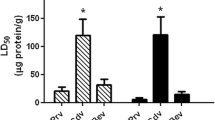Abstract
A comparative analysis of the venom alkaloids of 13 species of ants in the genus Monomorium collected in Africa was undertaken. Ants were collected in Kenya and South Africa. Most species produced 2,5-dialkylpyrrolidines and some of their analogous 1-pyrrolines. No alkaloids were detected in two species, M. robustior and M. macrops. Additionally, a novel 2-alkyl-1-pyrroline, whose structure was established by synthesis, was detected in M. notulum. This compound and others like it may serve as biosynthetic precursors for the formation of the 2,5-dialkylpyrrolidines found in many Myrmicine ant species.
Similar content being viewed by others
References
Andersen, A. N., Blum, M. S., and Jones, T. H. 1991. Venom alkaloids in Monomorium “rothsteini” Forel repel other ants: Is this the secret to success by Monomorium in Australian ant communities? Oecologia 88:157–160.
Bolton, B. 1987. A review of the Solenopsis genus-group and revision of Afrotropical Monomorium Mayr (Hymenoptera: Formicidae). Bull. Br. Museum Nat. Hist. 4:263–452.
Brand, J. M., Blum, M. S., Fales, H. M., and Macconnell, J. G. 1972. Fire ant venoms: Comparative analyses of alkaloidal components. Toxicon 10:259–271.
Deslippe, R. J. and Guo, Y.-J. 2000. Venom alkaloids of fire ants in relation to worker size and age. Toxicon 38:223–232.
Don, A. W., Jones, T. H., Flournoy, R. C., and Zottig, V. E. 2001. Venom chemistry of Monomorium antipodum Forel (Hymenoptera Formicidae) from New Zealand and its relavence to the taxonomy of the species. N. Z. Entomol. 24:49–52.
Heterick, B. E. 2001. Revision of the Australian ants of the genus Monomorium (Hymentoptera: Formicidae). Invert. Taxonomy 15:353–459.
Jones, T. H., Blum, M. S., Escoubas, P., and Musthak Ali, T. M., 1989. Novel Pyrrolidines in the venom of the ant Monomorium indicum. J. Nat. Prod. 52:779–784.
Jones, T. H., Clark, D. A., Heterick, B. E., and Snelling, R. R. 2003. Farnesyl amine form the ant Monomorium fieldi Forel. J. Nat. Prod. 66:325–326.
Jones, T. H., Blum, M. S., and Fales, H. M. 1982b. Ant venom alkaloids from Solenopsis and Monomorium species. Tetrahedron 38:1949–1958.
Jones, T. H., Blum, M. S., Howard, R. W., Mcdaniel, C. A., Fales, H. M., Dubois, M. B., and Torres, J. 1982a. Venom chemistry of ants in the genus. Monomorium. J. Chem. Ecol. 8:285–300.
Jones, T. H., Blum, M. S., and Robertson, H. G. 1990. Novel dialkylpiperidines in the venom of the ant Monomorium delagoense. J. Nat. Prod. 53:429–435.
Jones, T. H., Stahly, S. M., Don, A. W., and Blum, M. S. 1988. Chemotaxonomic implications of the venom chemsitry of some Monomorium “antarcticum” populations. J. Chem. Ecol. 14:2197–2212.
Jones, T. H., Torres, J. A., Spande, T. F., Garraffo, H. M., Blum, M. S., and Snelling, R. R. 1996. Chemistry of venom alkaloids in some Solenopsis (Diplorhoptrum) species from Puerto Rico. J. Chem. Ecol. 22:1221–1236.
Macconnell, J. G., Blum, M. S., Buren, W. F., Williams, R. N., and Fales, H. M. 1976. Fire ant venoms: Chemotaxonomic correlations with alkaloidal compositions. Toxicon 14:69–78.
Pedder, D. J., Fales, H. M., Jaouni, T., Blum, M., Macconnell, J., and Crewe, R. M. 1976. Constituents of the venom of a South African fire ant (Solenopsis punctaticeps). Tetrahedron 32:2275–2279.
Ritter, F. J. and Persoons, C. J. 1975. Recent developments in insect pheromone research, in particular in the Netherlands. Neth. J. Zool. 25:261–275.
Spande, T. F., Jain, P., Garraffo, H. M., Pannell, L. K., Yeh, H. J. C., Daly, J. W., Fukumoto, S., Imamura, K., Tokuyama, T., Torres, J. A., Snelling, R. R., and Jones, T. H. 1999. Occurrence and significance of decahydroquinolines from dendrobatid frogs and a myrmicine ant: use of 1H and 13C NMR in their conformational analyses. J. Nat. Prod. 62:5–21.
Stetter, H., Basse, W., and Nienhaus, J. 1980. Addition von aldehyden an α, β-ungesättige carbonsaureester und nitrile. Chem. Ber. 113:690–698.
Torres, J. A., Zottig, V. E., Co, J. E., Jones, T. H., and Snelling, R. R. 2001. Caste specific alkaloid chemistry of Solenopsis maboya and S. torresi (Hymentoptera: Formicidae). Sociobiology 37:579–583.
Vander Meer, R. K., and Lofgren, C. S. 1988. Use of chemical characters in defining populations of fire ants, Solenopsis saevissima complex (Hymenoptera: Formicidae). Fla Entomol. 71:323–332.
Author information
Authors and Affiliations
Corresponding author
Rights and permissions
About this article
Cite this article
Jones, T.H., Zottig, V.E., Robertson, H.G. et al. The Venom Alkaloids from Some African Monomorium Species. J Chem Ecol 29, 2721–2727 (2003). https://doi.org/10.1023/B:JOEC.0000008015.42254.c3
Issue Date:
DOI: https://doi.org/10.1023/B:JOEC.0000008015.42254.c3




